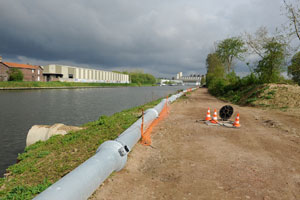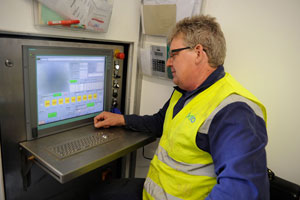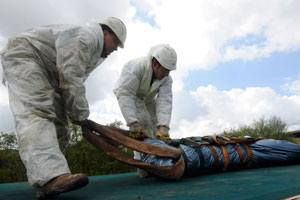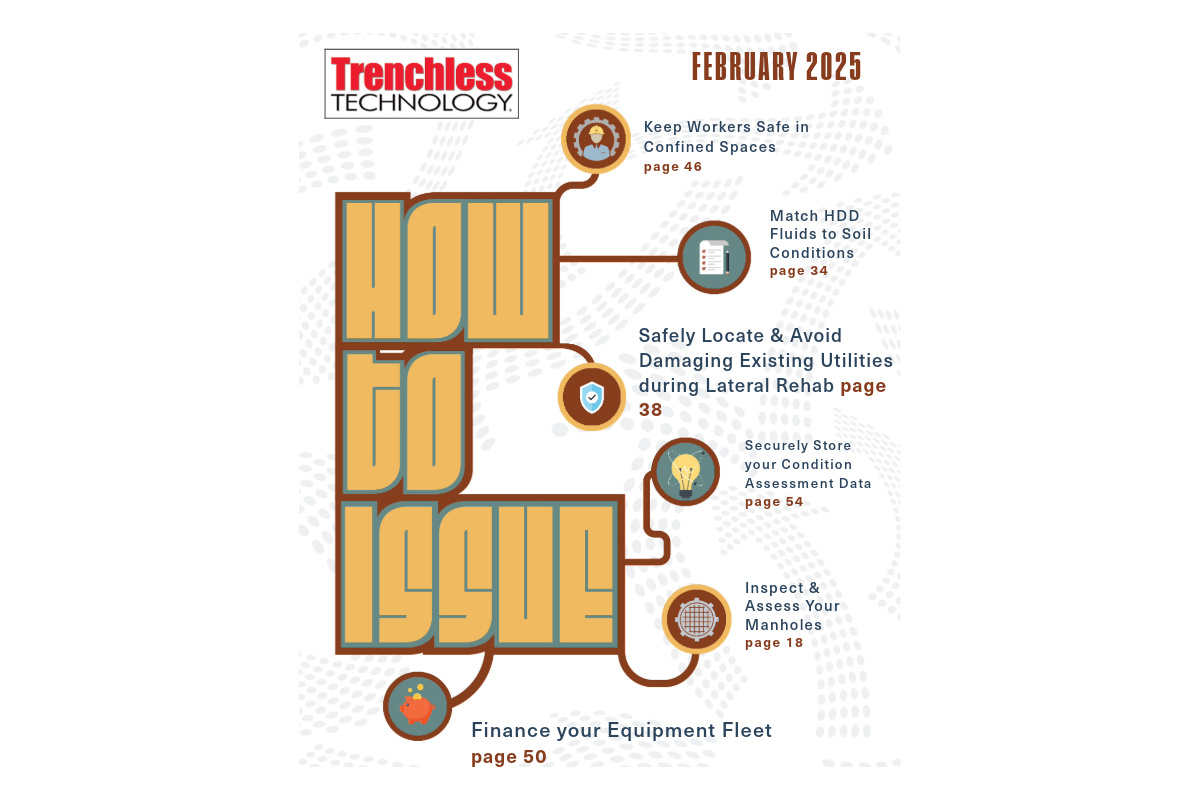AXEO Brumath Completes Largest Pipe Lining Project in France to Date
August 24, 2011
 Near the City of Lille in the north of France, 4 km of sewer drains were recently rehabilitated. For this purpose, UV-light curing pipe liners DN 600 to DN 1200 made by RELINEEUROPE where used.
Near the City of Lille in the north of France, 4 km of sewer drains were recently rehabilitated. For this purpose, UV-light curing pipe liners DN 600 to DN 1200 made by RELINEEUROPE where used.While sceptical at the beginning, the municipal client, Lille Métropole Communauté urbaine (LMCU), could finally be convinced by the benefits of trenchless sewer rehabilitation with the Alphaliners from RELINEEUROPE. The contract with such a remarkable size was unprecedented to that date. The job was awarded to sewage system specialist AXEO Brumath, France. The project had to be completed within only a few months between March and July 2011.
In Emmerin near Lille in northern France, the main intercepting sewer leading to wastewater treatment plant had become derelict. The sewage system that had been built in the 1970s was showing major signs of damage. Although there was nothing wrong with the statics of the old pipes, excessive corrosion, displaced pipe couplings and penetrating roots were causing leaks in the sewage system. Parts of the pipe system were overgrown by up to 90 percent. The need for rehabilitation was unavoidable. With an overall pipeline length of 4 km and pipe diameters of up to DN 1200, the rehabilitation project was thus a very demanding project that had to be completed within a very tight schedule. The sewage system runs along a nature reserve, which will likely be restructured in mid-2011.
“This is the largest project of this kind in France up to this date. Considering the length, diameters and short completion time, the entire French rehabilitation industry is considering this task as a reference project,” says Michel Moller, construction supervisor at AXEO Brumath.
Up to this date, the GFRP lining system and the UV technology were unknown to the client. The decision-makers were thus somewhat skeptical at the beginning. But the documentation of previous installation results and successfully implemented projects finally convinced the client. In addition, the Alphaliner method from RELINEEUROPE was recently also certified in France by the CSTB (Scientific Centre of Technology and Construction, France).
Narrow Timeframe
 The challenge for the professionals at AXEO Brumath was to complete the project, including all preparation and finishing work within the narrow time frame. The pipes affected are two main intercepting sewers. One of these with a length of 1,255 m and a diameter of DN 1000 runs from the pumping station at the nearby industrial area and the port Santes along the nature reserve “Le parc de la Deûle” to the wastewater treatment plant. The second intercepting sewer DN 1200 that was to be rehabilitated has a length of 3,009 m and connects the commune Wattignies with the wastewater treatment plant. A feed pipe with a length of 243 m and a diameter of DN 600 leading to this main intercepting sewer has already been rehabilitated.
The challenge for the professionals at AXEO Brumath was to complete the project, including all preparation and finishing work within the narrow time frame. The pipes affected are two main intercepting sewers. One of these with a length of 1,255 m and a diameter of DN 1000 runs from the pumping station at the nearby industrial area and the port Santes along the nature reserve “Le parc de la Deûle” to the wastewater treatment plant. The second intercepting sewer DN 1200 that was to be rehabilitated has a length of 3,009 m and connects the commune Wattignies with the wastewater treatment plant. A feed pipe with a length of 243 m and a diameter of DN 600 leading to this main intercepting sewer has already been rehabilitated. The initial phase involved restoring the segment from the pumping station to the wastewater treatment plant. This required the installation of a 1.4-km water bypass system through which the water could flow from the industrial area to the wastewater treatment plant during the construction phase.
Moller explains, “Designing the water drainage bypass as a single, large system makes sense. It enables us to perform work along the entire construction site efficiently without any major loss of time caused by e.g. daily sewer cleaning.”
In this first segment, DN 1000 Alphaliners with a wall thickness of 7.2 mm have been installed over a length of 1,255 m. The logistics on their own in this respect were immense. The total weight of all installed liners amounts to approximately 236.5 tons. RELINEEUROPE supplied the liners in the lengths required for the respective installation segments. The Alphaliners were then pulled into the sewer directly from the lorry with the help of a conveyor. Also onsite was David Veltz from RELINEEUROPE who had already cooperated closely with AXEO Brumath during the preparation phase.
“Obviously, entering the French market with such a large project is a challenge for us. But we all acted in concert, from the production employees to the management. That the project was a success is due to the good cooperation between the city of Lille, AXEO Brumath and RELINEEUROPE,” says Veltz.
Fast Curing Meant Shorter Installation Time
 Once completed, work on the approximately 3,000 m long intercepting sewer was carried out. Again, the construction vehicles were only able to drive to the drainage system on specially built construction roads. Thanks to the clever choice of the installation segments and the deployment of two construction crews at the same time, the construction team around construction supervisor Moller was able to complete the construction work even faster than originally planned. Up to five liners were installed per week.
Once completed, work on the approximately 3,000 m long intercepting sewer was carried out. Again, the construction vehicles were only able to drive to the drainage system on specially built construction roads. Thanks to the clever choice of the installation segments and the deployment of two construction crews at the same time, the construction team around construction supervisor Moller was able to complete the construction work even faster than originally planned. Up to five liners were installed per week.RELINEEUROPE opted for various logistics solutions to implement the order. The Alphaliners DN 1000, for example, were delivered in individual boxes. The larger DN 1200 Alphaliners, however, were delivered in overseas containers. The benefits are simple: “With this method, we are much more flexible and also more environmentally friendly, since we do not use disposable packaging. We are thus also able to deliver very heavy liners reliably to the construction site,” says Veltz.
 Onsite, the large-dimensioned liners were pulled into the sewer system with a cable winch. By using a 1.5-km long winch cable, the setup time between the individual installation segments could be kept to a minimum. Once the liners were inflated, UV light was used for the curing process at a speed of approximately 40 cm per minute. To achieve this, a light train of nine UV lamps with a capacity of 1,000 watt each were moved along the installed liner. The curing process thus only took a few hours even with longer installation sections. Thanks to the clearly structured work and very fast processing method, up to 150 m of sewer pipes could be rehabilitated on an average work day. Meeting the tight timeframe of the trenchless sewer project was therefore no longer a problem.
Onsite, the large-dimensioned liners were pulled into the sewer system with a cable winch. By using a 1.5-km long winch cable, the setup time between the individual installation segments could be kept to a minimum. Once the liners were inflated, UV light was used for the curing process at a speed of approximately 40 cm per minute. To achieve this, a light train of nine UV lamps with a capacity of 1,000 watt each were moved along the installed liner. The curing process thus only took a few hours even with longer installation sections. Thanks to the clearly structured work and very fast processing method, up to 150 m of sewer pipes could be rehabilitated on an average work day. Meeting the tight timeframe of the trenchless sewer project was therefore no longer a problem.Apart from saving time and protecting the environment, trenchless sewer rehabilitation with UV light curing GRP liners has yet another advantage.
After 30 years of experience in sewer rehabilitation using hot water as the curing medium, I am now able to compare the two methods,” says Moller. “In addition to the advantages for the environment, the UV system also has benefits for the residents. While hot water curing requires the construction site to be manned day and night, this method allows interruptions and can be continued the following day.”
This article was submitted by RELINEEUROPE, headquartered in Rohrbach, Germany.



